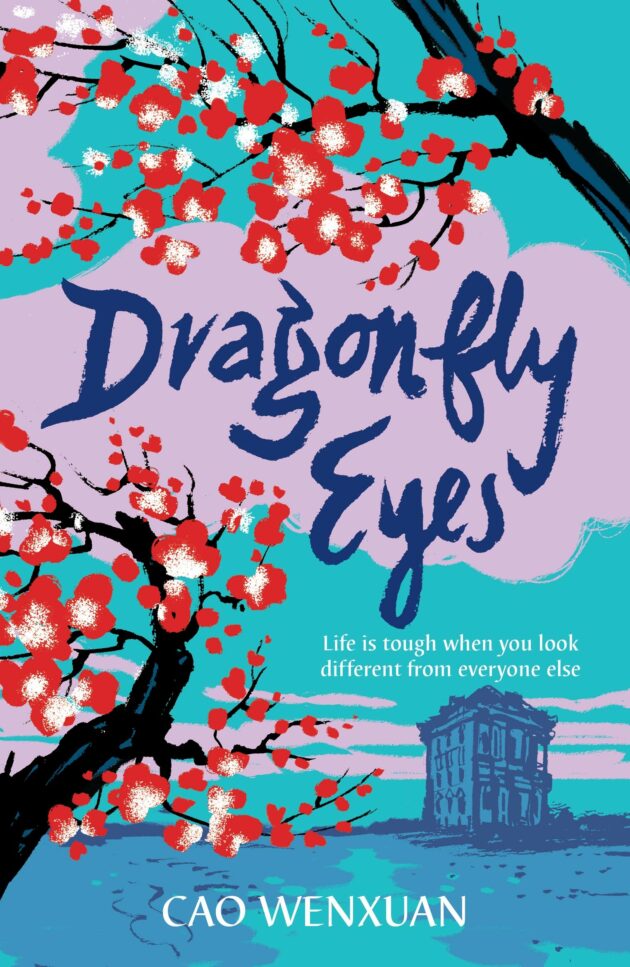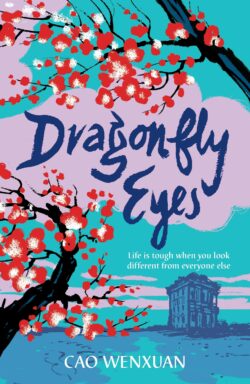
Dragonfly Eyes by Cao Wenxuan, translated by Helen Wang. London – reviewed by Avery Fischer Udagawa

Dragonfly Eyes by Cao Wenxuan, translated by Helen Wang. London: Walker Books, 2021. Paperback. 384 pages, ¥1350 (paper).
The beginning of Dragonfly Eyes by Cao Wenxuan, translated by Helen Wang, reads like a storybook ending: A young Chinese widower, sailor, and heir to a silk empire meets a delightful French woman in a café in Marseilles during shore leave. Within weeks the two decide to marry, and he succeeds his father as head of the silk company’s European operations. The couple welcome four children, whom they raise bilingually in French and Shanghainese in Lyons, and when World War II sends them to Shanghai, they welcome two older stepchildren into their family. They live and thrive in a cheery “Blue House” designed by a German architect, and as children marry and grandchildren arrive, one—Ah Mei, or in French, Aina—grows close to her grandmother, Oceáne, becoming a joy of her later life.
Tender devotion among family members, especially between Ah Mei and Oceáne, runs through Dragonfly Eyes but must assume ever-evolving forms, as cascading hardships soon befall Shanghai and the Blue House: war and postwar scarcity, state takeover of family assets, and violent xenophobia during the Cultural Revolution. Oceáne is accused of being a foreign spy; Ah Mei and a cousin are harassed and abused due to their connection with her and to being mixed-race. Oceáne, who came to Shanghai a mature adult, can process the hateful acts with her self-image intact, but having their schools and city turn on them sends her adolescent descendants to their mirrors, seeing their quarter-French features anew and wondering, Am I a monster? Even Ah Mei begins to dislike her Oceáne-like features, “all the things that she had loved about herself.”
Oceáne understands that she helped cause Ah Mei’s pain and strives to allay it, with mixed results. In one poignant chapter, she has her husband’s seaman’s uniform and a beloved dress from her youth remade into clothes for Ah Mei—the family can no longer afford cloth—so that Ah Mei can play piano at a school arts event. After feeling increasingly isolated at school, where she was once a favorite, Ah Mei was thrilled to be asked to perform, thinking it meant, “She was still their treasure, like always!” Oceáne, for her part, has cherished hopes that “the loneliness, rejection and uneasiness” will disappear when Ah Mei, smartly dressed, plays the pieces she polished at the family piano, itself briefly pawned to cover a hospital bill.
Ah Mei arrives at school for the concert only to learn that the headteacher who selected her has been dismissed, and her recital is canceled.
Bitter disappointments and agonies only mount after this, with Ah Mei’s traumatized cousin withdrawing from the world and Oceáne subjected to home raids and forced-labor at a brick field. Ah Mei must move to Yubin with her parents, who work at a factory that was relocated to the interior. Oceáne and Ah Mei strive to keep their connection however they can, and Ah Mei intuitively supports Oceáne’s final bid to preserve her, and their, love and dignity.
But a storybook ending never transpires—and herein lies this translation’s contribution to literature in English for young readers. Many a children’s novel offers likable characters, a struggle, and a happy denouement, but few explore how good people can struggle relentlessly, yet still see their cherished dreams go unrealized. Few books ask young readers to consider whether the struggle still matters even if tragedy is all but assured. Few books ask children if dreams can be sacrificed.
During the period when I was writing this review, I found myself driving my ten- and thirteen-year-old daughters in the car when a radio commentator mentioned “global planetary emergency,” “dysfunction of democracy,” and “chaos and breakdown of the global order.” I did not know how to handle the girls’ fear in that moment; indeed, I often feel stymied when they ask if political or climate crises will derail their lives. I want to urge them to stay hopeful yet never ignore their reality. I want to tell them that even if their fears come true and they must radically adjust their expectations for life, their acts of courage and hope will still matter; in fact, their acts of courage and hope will give them courage and hope. And, they will face grief.
Novels like Dragonfly Eyes and the acclaimed Cao/Wang title Bronze and Sunflower—also set during the Cultural Revolution, in the countryside—show hopeful struggle amid tragedies playing out in a past so vivid, it could be now. Which is why we need it now. We need its way of storytelling and seeing.

[The U.S. edition of Dragonfly Eyes will be published by Candlewick Press in Summer 2022].

Avery Fischer Udagawa is a long-time contributor to KJ; her profile of sinologist, translator and activist Helen Wang will appear in KJ102.